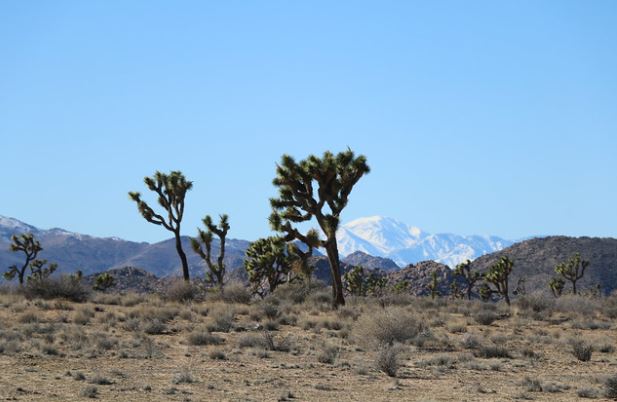Yucca brevifolia in San Bernardino County, California
Photo by JGilkeson/USFWS, 2017
Iconic Desert Plant Threatened by Climate Change, Habitat Loss
April 14, 2020 - SACRAMENTO, Calif.— The California Department of Fish and Wildlife on Monday recommended that western Joshua trees move toward  protection under the state’s Endangered Species Act. The action came in response to a petition from the Center for Biological Diversity.
protection under the state’s Endangered Species Act. The action came in response to a petition from the Center for Biological Diversity.
The iconic trees are threatened by climate change and habitat destruction from urban sprawl and other development in their Mojave Desert home.
“We’re elated that Joshua trees are a step closer to protection,” said Brendan Cummings, the Center’s conservation director and a Joshua Tree resident. “These beautiful trees face huge threats that could drive them extinct in the wild. We urge the state to finalize these protections quickly so Joshua trees can survive and thrive in California for generations to come.”
In October the Center petitioned the state to protect western Joshua trees under the California Endangered Species Act. In June California’s Fish and Game Commission will decide whether to accept the department’s recommendation and grant these imperiled plants candidate status under state law.
A candidate designation triggers a yearlong review of whether the species should be formally protected under the state act. The species is legally protected during the review period.
Recent studies show Joshua trees are dying off because of hotter, drier conditions, with very few younger trees becoming established. Even greater changes are projected over the coming decades. Scientists earlier this year projected that the Joshua tree will be largely gone from its namesake national park by the end of the century.
Last year the Trump administration denied federal protection for the species.
“California needs to ensure these spectacular trees remain part of California’s landscape in perpetuity,” said Cummings. “The Trump administration has abdicated its responsibility to save Joshua trees and hundreds of other species threatened by climate change. The state must fill that void and lead efforts to ensure the Joshua tree’s survival.”
Climate change could wipe out western Joshua trees, which already are failing to reproduce at drier, lower elevations. Prolonged droughts are projected to be more frequent and intense over the coming decades, shrinking the species’ range and leading to more tree deaths. Higher elevations, where Joshua trees might survive increasing temperatures and drying conditions, are at risk of fire due to invasive non-native grasses.
The western Joshua tree is also threatened by habitat loss and degradation. Outside of Joshua Tree National Park, off-road vehicle use, cattle grazing, powerlines and pipelines and large-scale energy projects are destroying habitat. Approximately 40 percent of the western Joshua tree’s range in California is on private land, with only a tiny fraction protected from development. Current projections show that virtually all of this habitat will be lost without stronger legal protections for the trees.
“The California Endangered Species Act may be the only hope for saving these iconic symbols of the Mojave Desert,” said Cummings. “Joshua trees are uprooted or bulldozed on a daily basis to make way for roads, powerlines, strip malls and vacation rentals right up to the borders of our national parks. If these beautiful plants are to have any hope of surviving the difficult decades ahead, we have to stop killing them.”
The Joshua tree has recently been recognized as composed of two distinct species, the western Joshua tree (Yucca brevifolia) and the eastern Joshua tree (Y. jaegeriana). The two species occupy different areas of the desert, are genetically and morphologically distinguishable, and have different pollinating moths.
Today’s recommendation addresses the western species. The western Joshua tree has a boomerang-shaped range stretching from Joshua Tree National Park westward along the northern slopes of the San Bernardino and San Gabriel Mountains, through the Antelope Valley, northward along the eastern flanks of the southern Sierra Nevada and eastward to the edges of Death Valley National Park and into Nevada.
The eastern Joshua tree’s range in California is centered in the Mojave National Preserve and extends eastward into Nevada, Arizona and Utah.
If Joshua trees win protection under California’s Endangered Species Act, state and local agencies will have to manage threats to them, including developing a recovery plan outlining a strategy to protect the species in the face of climate change.
The Center for Biological Diversity is a national, nonprofit conservation organization with more than 1.7 million members and online activists dedicated to the protection of endangered species and wild places.
Source: Center for Biological Diversity









